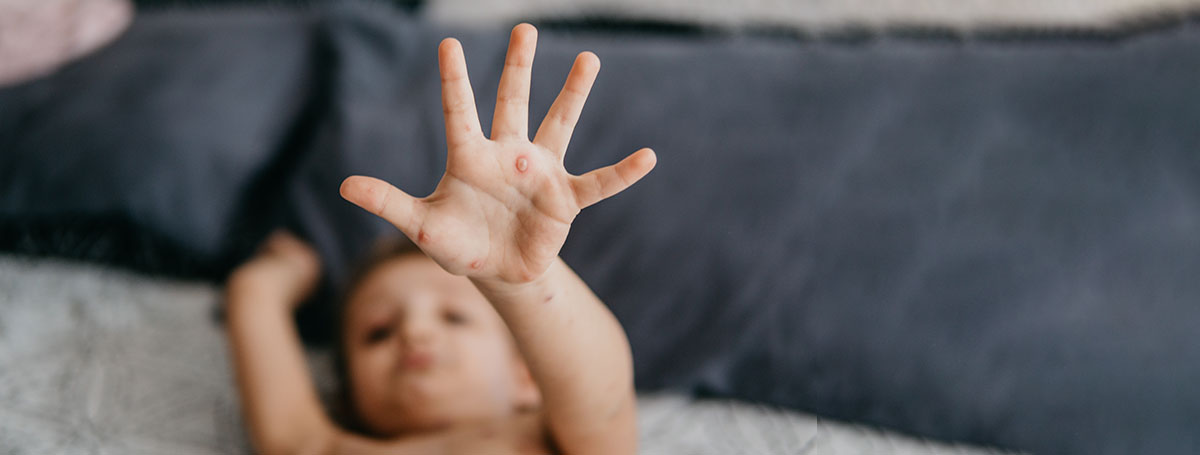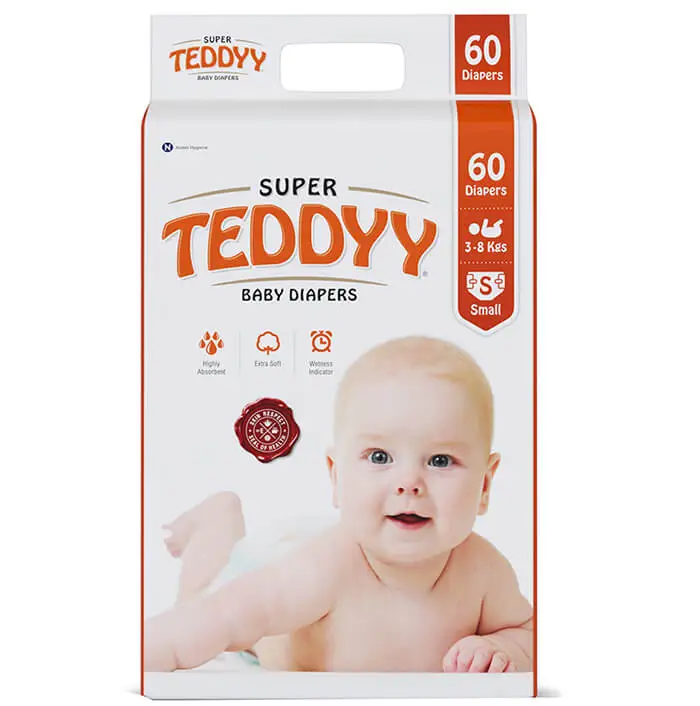Chickenpox in Children: Symptoms, Diagnosis, and Treatment
The hardest thing for a parent is seeing their child in discomfort; but the infamous chickenpox is a rite of passage that every child must go through. Interestingly, once caught, many may develop lifelong immunity to the virus, conquering it for good!
Learn everything you need to know about chickenpox in children right here in this blog!
What is chickenpox?
Chickenpox, also known as varicella, is a highly contagious viral disease caused by the varicella-zoster virus. Typically, it resolves within a week or two. It can affect individuals of all ages, today we’re focusing on its impact on children.
Due to its contagious nature, most cases of chickenpox in children occur through contact with someone else who is already infected, a sibling, classmate or whoever has it. The virus generally spreads through tiny droplets in the air when an infected person coughs or sneezes; or through direct contact with chickenpox sores or contaminated objects.
So, if your child has chickenpox, it’s important for them to stay at home and rest until the virus runs its course. This measure is not only for their own well-being but also to prevent spreading the virus to their friends and classmates.
What are the symptoms of chickenpox?
The symptoms usually appear 10 to 21 days after contact with the virus. It starts with flu-like symptoms such as:
- A fever
- Poor appetite
- Feeling tired
- Muscle ache
- Sore throat, cough, and runny nose
- Headache
And then, in less than two days, the classic symptom emerges: itchy rashes that transform into fluid-filled blisters. These red and itchy rashes or bumps commonly appear initially on the face, scalp, chest, or back, and then spread throughout the body. The rash may be mild or severe, and in over two to 4 days, as many as 200 to 500 itchy bumps can erupt all over the body in several waves.
The chickenpox rash has several stages you should know about. The itchy bumps that have erupted all over the body develop into thin-walled, fluid-filled blisters. Eventually the blister walls break and resemble open sores. The sores then start to scab over and heal.
Since the rashes appear in waves, some start to scab over and heal, while new rashes and bumps appear at the same time. So, don’t be alarmed by that.
How long will your child be contagious?
Your child becomes contagious as soon as flu-like symptoms appear and remains contagious until all the blisters have scabbed over and healed.
To be on the safe side, it’s recommended to quarantine your child for an additional two or three days. If you’re not sure if the illness has truly passed, just ask your doctor, and they can help you.
Some precautions to avoid transmission of the virus
When caring for your child with chickenpox, it is crucial to take extra precautions to prevent the spread of the virus. This is especially important because unvaccinated individuals, newborns, pregnant women, and those with weakened immune systems are at a higher risk of developing health complications due to the chickenpox virus.
Here are some precautions you can take:
- Wash your hands with soap frequently (bonus points for using hand sanitizers).
- Trim your child’s nails to minimize the risk of scratching and breaking the blisters.
- Do not share personal items. As a personal anecdote, my mother had a precautionary measure when someone in our family had chickenpox. She would have us sleep on a dedicated floor mat or chatai and restrict our movements to that area – no going outside the mat except for baths. Once the illness had passed, she would discard the mat along with any personal hygiene products we used during that time.
- Get yourself vaccinated if you haven’t been already.
- Wear a mask just in case.
Chickenpox treatments and home remedies
Since chickenpox is a viral disease and goes away on its own, it’s not treated with antibiotics. However, scratching and rubbing the blisters can lead to secondary infections around the blisters, which can be treated by antibiotics prescribed by your child’s doctor. So, until chickenpox goes away, home remedies are your best bet.
Here are some of the best chickenpox home remedies that can ease your child’s experience with chickenpox:
Apply neem paste on the blisters
A classic Indian home remedy for chickenpox! The neem leaves are loaded with antiviral and antibacterial properties and applying neem paste can provide instant relief from itching and accelerate the healing process of the dry blisters.
Simply grind the neem leaves into a paste and apply it on the blisters and leave it there for a few hours. In a few hours, it’ll dry up and fall off on its own. You can also give your child neem bath by adding some neem leaves to lukewarm water.
Give a baking soda bath
A common myth in India is that you shouldn’t take a bath if you have chickenpox; it’s a well-intended advice to prevent any rubbing or scratching when drying yourself off, and to prevent the scabs – which are infectious too – from falling all over the place. But at the end of the day, it’s just a myth, and bathing might actually soothe chickenpox symptoms.
Baking soda has antimicrobial and anti-inflammatory properties that can help soothe itching and aid in fast recovery. Add a cup of baking soda to the water in a tub or bucket and allow your child to soak or shower with it for 10 to 15 minutes.
Make them guava leaves tea
Guava leaves are rich in Vitamin C, which may help prevent scars. They are also often used in Ayurvedic and Chinese medicine to treat skin irritations and infections.
So, take 10-12 guava leaves and boil them in 2 cups of water for 10-15 minutes. Strain the liquid and add a little honey to taste, then savor it while it’s warm. It can be consumed twice daily.
Our Products
Apply calamine lotion
Calamine lotion contains skin soothing properties and prevents secondary infections around the blisters. Oh, and whenever you are applying anything on your child’s blisters, make sure your hands are clean and hygienic.
On another note, remember that if your child’s blisters are painful or if your child has a fever, DO NOT GIVE THEM ASPIRINS. Taking aspirin during or while recovering from a disease like chickenpox can increase their risk of a rare yet serious condition called Reye’s syndrome – a disorder that can cause liver and brain damage.
When to contact your doctor?
In most cases, medical treatment is not needed at any point during the course of the illness. But things can go south in some cases. Call your doctor if your child has:
- A fever for more than 4 days
- Trouble breathing or has severe cough
- A severe headache
- Pus leaking from the chickenpox rash or if the rash becomes red, warm, or swollen.
- A stiff neck or has trouble walking
- Is vomiting and seems very ill
- Difficulty looking at bright lights
- Is drowsy or seems confused
You know your child best, so if you are concerned your child is unwell, trust your gut and seek medical attention immediately.
Hope you’ve found this blog helpful! It’s easy to catch chickenpox, so keep your child away from schools, daycares, summer camps, and childcare until the last blister is healed.
Fortunately, once your child has had chickenpox, they may develop lifelong immunity to the virus, protecting them from future infections. However, it’s important to be aware of the risk of shingles. After a person recovers from chickenpox, the virus remains dormant in their body and can reactivate years later, causing shingles. But shingles is a topic for another blog! Take care and see you!


To care for a child with chickenpox:
- Keep their fingernails short to prevent scratching and reduce the risk of spreading infection further.
- Use cool baths or calamine lotion to soothe itching.
- Dress them in loose, comfortable clothing made of natural fibers such as cotton.
- Avoid exposing your child to direct sunlight or extreme temperatures.
- Offer plenty of fluids to prevent dehydration.
Chickenpox is highly contagious, and it starts spreading around 1 to 2 days before the appearance of the rash. It continues until all the blisters have scabbed over and healed.
The chickenpox vaccine commonly used for children is called the varicella vaccine. It is typically administered in two doses, with the first dose given between 12-15 months of age and the second dose between 4-6 years of age.
Some natural remedies that may help improve the appearance of deep chickenpox scars over time are:
- Aloe vera: Apply fresh aloe vera gel to the scars and leave it on for 30 minutes before rinsing off. Repeat this process daily.
- Honey: Apply raw honey to the scars and leave it on for 15-20 minutes before rinsing off. Repeat daily.
- Vitamin E oil: Apply vitamin E oil directly to the scars and massage gently. Repeat this process daily.
Before trying out home remedies we’d recommend doing a patch test on a small area of your skin. If you don’t experience any irritation, you can go ahead and reap the benefits of these remedies to their full extent!
Chickenpox typically gets better by itself after 1 to 2 weeks, but for some individuals it may take longer or require a visit to the doctor.





